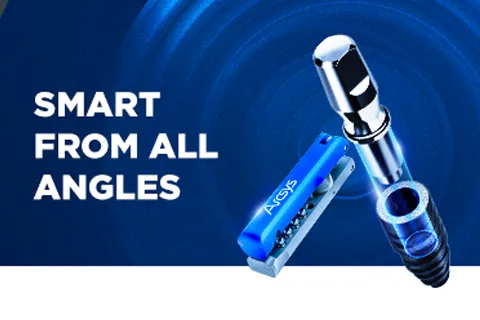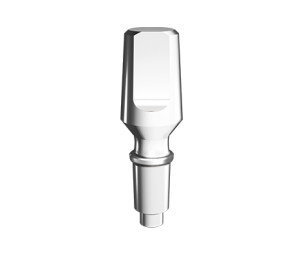

Customizable prosthetic components, developed in special high strength and biocompatibility alloys, recommended for unitary cement-retained rehabilitations.
They allow the professional to quickly and practically customize the angulation according to the needs of each patient. They have dynamic termination, providing much more safety to peri-implant tissues.
They are made of stainless steel in accordance with ASTM F138 and ISO 5832-1. They have high mechanical strength and clinical versatility.
PLEASE NOTE! After the plastic deformation (crystalline modification of the metal structure) promoted by the Abutment folding device, the prosthetic component CANNOT be refolded.

Customizable Angle:
Allows angulation from 0º to 20º, obtaining better esthetic and functional results.
Stainless Steel:
Biocompatible, highly resistant and reliable product.
100% Inspected:
The connections are produced with a high degree of quality, with "one by one" inspection throughout the prosthetic components line.
Interchangeability:
Arcsys prosthetic components are interchangeable and can be used regardless of the diameter of the chosen implant.
Versatility:
Available with different heights and diameters to adapt the variations of prosthetic space and gingival phenotype.
Security:
Its massive and robust design ensures the use with a success rate far superior to the competitors of the market, being 3x more resistant.
The standard ABNT NBR 16044:2012 defines the general requirements for dental implants. It specifies several elements and, among them, the contact between materials of different chemical composition. That standard mentions another (ABNT ISO 21534), which defines that the combination of stainless steel ASTM F138-13a (used as a manufacturing material for intermediate pieces) and of Ti6Al4V (used in the manufacture of implants) is considered acceptable for the application, and can be used without problems.
Physical factors.Therefore, it is important to observe them to guarantee the passivity of the penetration of the component in the implant chamber. Possible factors: 1) Fragments inside the implant preventing the component to go all the way down. Solution: irrigate the interior of the implant under pressure and aspirate with an endodontic cannula (be especially careful when the implant installed is associated with gap filling). 2) Excess liquid (blood, saline solution) inside the implant. Solution: irrigate the interior of the implant with pressure and aspire with an endodontic cannula. 3) Correct selection of the transmucosal height, so that it allows for the component to go down to its final course inside the implant without interfering with the bone crests or soft tissues. Solution: adapt the transmucosal height to avoid pressure of soft tissues over the component and verify if there is passivity in the course of the component down the implant. If there is contact with the bone crest, it is necessary to ream the area to guarantee the passivity of the seating. 4) Activation of the Installation Device according to the instructions. Solution: align the device to the implant axle according to the use instructions, activate the trigger correctly (holding in the specified area) and apply at least three complete strokes. 5) Contact spots in the prosthetic portion forbidding the prosthesis/component set to go all the way down when placed together. Solution: check the contact spots of the prosthesis and alleviate if necessary. Check with the dental floss. 6) Occlusal adjustment (when there are no de-occlusion guides). Solution: adjust the anterior and lateral guides. In a case of light occlusion (MIH), the prosthesis should not show a mark with Accufilm. In forced occlusions, the prosthesis will show a light mark. That should be due to the absence of the periodontal ligament.
No. Once the crystalline configuration of the foldable prosthetic components is altered, it should not be rearranged again. Hardening is a plastic deformation that promotes the increase of the resistance force of non-ferrous alloys. The plastic modification of a hardened body (re-angulation) in either direction and in any degree, may cause microscopic fissures which may compromise the resistance of those components and lead to cracks and even fractures.
Their removal is possible and safe, if the professional holds the component with its respective extracting wrench. All that is needed is to perform torsion and traction movements simultaneously (around 30N are enough for nulling the Morse Taper effect). It is important to assess the presence of para-functions (such as bruxism). In those cases, the occlusion needs to be adjusted according to the basic premises that generate them (freedom of excursive movements and selective touch during de-occlusion guides). There is no possibility of the component to loosen up during mastication, since the compressive direction favors even more the bracing of the components.
The prosthetic components are made of stainless steel, intended for use in implantable products, in accordance with American Standard ASTM F138.
FGM’s Foldable Components are manufactured according to standards ASTM F138-13a and ABNT NBR ISSO 5832-1:2008, which define the characteristics of the chemical composition, mechanical properties, the microstructure and the requirements for the application of those materials in implantable products. The components undergo a series of tests, both static fatigue (compression test), and dynamic fatigue. According to the results obtained, the limit resistance force (Flr) reached an average value of 1725N, which corresponds to the static fatigue test of the prosthetic components in the worst scenario (Arcsys 3x6x5.5mm Foldable Abutment, angled to 20°), or rather, a value much higher thatn the study carried out by Ferrario et al (2004), which showed that the average maximum force naturally applied to a single tooth (first molar) of a healthy male adult is 306N.
We carried out static fatigue tests on the component assembled over the implant, simulating the most critical condition, defined by the component with the highest trans-mucosal height and lower bulkiness (Arcsys 3x6x5.5mm Foldable Abutment already angled to 20°). This test was conducted according to the standard ABNT NBR ISO 14801:2012, which defines a standardized method for the verification of mechanical resistance of components under static fatigue (compression test) and dynamic fatigue. For that test, the component resisted to an average value of 1725N, or rather, a value much higher that the one from the study carried out by Ferrario et al (2004), which showed that the average maximum force applied to a single tooth (first molar) of a healty adult male is, approximately, 306N.
Yes. That may occur in two specific situations: 1) if the force applied for the torque of the prosthetic screw surpasses 30N (The recommendation is 10N for the stabilization). 2) If the prosthetic component is sub-braced. In that case, it will not be fully activated, and its bracing may be reverted with a force weaker than 30N.
The activation is carried out through mechanical impact, by means of a proper tool. The implant installation device was designed to allow that activation to happen in an adequate way, providing safety for the user and the patient. The ideal hold achieved depends on the number of activations the professional applies to the prosthetic component. We recommend at least three (3) impacts, to allow for a reliable hold. The professional can complement the activation with more impacts and that does not damage the set.
There are many advantages. The professional may easily customize them, they allow selective reaming and reembasament (with acrylic or composite resins), they generate visual contrast with the adjacent tissues, they decrease work time and are economically more viable. They allow enough mechanical support without damaging the Morse Taper of the implant or component as the material shows lower hardness than titanium. If necessary, they can be customized by the professional, both with reaming as well as reembasament. The fact that they are multifunctional facilitates the clinical control and optimizes stock, considerably reducing the amount of materials purchase for rehabilitations over implants.
The transmucosal height is the distance from the top of the implant to the beginning of the prosthesis. Because it is a Morse system, the implant has to be submerged in relation to the bone level (2-3mm). To that distance, add the thickness of the gum. The total value obtained should allow the formation of a new biological space. The professional must pay attention to the need to hide the end of the gum in approximately 1 mm. Those values should be measured with a trans-mucosal meter. The decision on the height can also be delayed until after the conditioning by the healing abutment, and then the component can be chosen. Important note: It is crucial to activate the selected component only after the verification that the correct height has been chosen. Otherwise, there may be loosening, sub-bracing, exposition of the prosthetic termination, etc. Besides, if there is damage during the replacement of the component, quality may be compromised.
The removal of temporary crowns or multifunctional transfers such as caps has to be done only through traction, not rotation. In those situations, it will detach with a force weaker than 212N, the force needed to free the implant/component set after 3 impacts by the installation device.
NO. The structural modification of already encruated components will compromise the mechanical performance of those intermediate elements. That attitude may bring serious risks of catastrophic consequences (fracture) during the functional use of those elements. It is recommended that encruated components do not undergo any additional plastic deformation, even if in the same direction of the initial one.
Although it is unprecedented in implantology, the alloy used is implatable and has been used for a long time in the medical area in implants, exactly because of its adequate biological response to tissues. This fact is evidenced by the United States standard ASTM F138-13a.

We provide direct links to publications from major scientific portals containing studies conducted with our products.

Componentes Arcsys, Vezza e Fluxo Digital até 60% OFF, promoções em Brocas, kit cirúrgicos e muito mais.